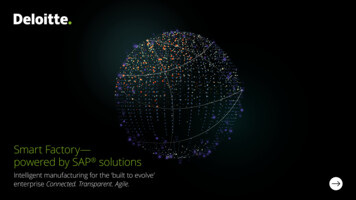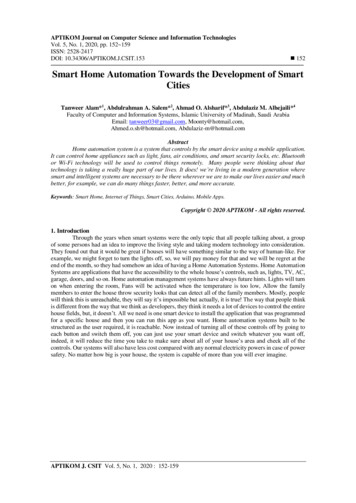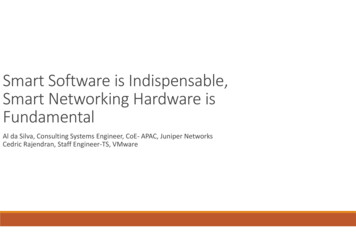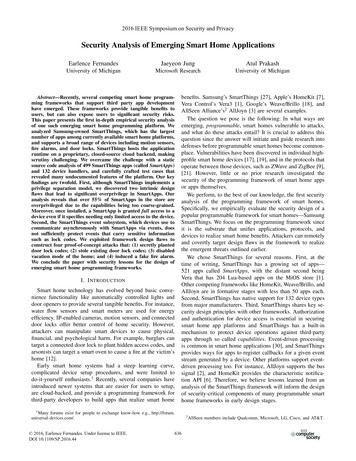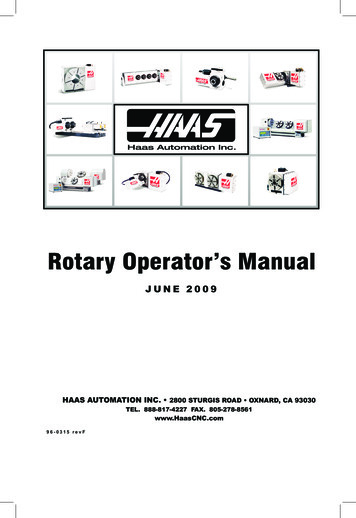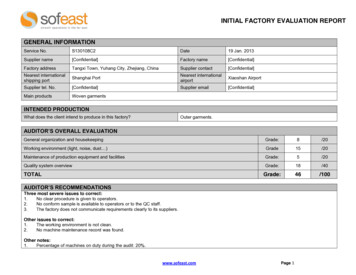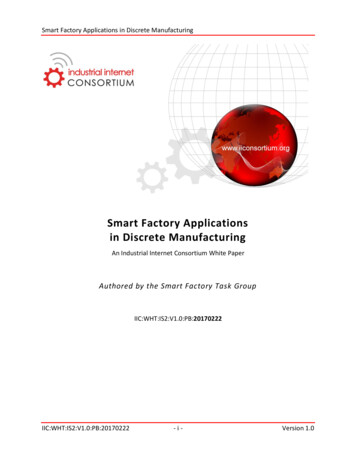
Transcription
Smart Factory Applications in Discrete ManufacturingSmart Factory Applicationsin Discrete ManufacturingAn Industrial Internet Consortium White PaperAuthored by the Smart Factory Task PB:20170222-i-Version 1.0
Smart Factory Applications in Discrete ManufacturingTABLE OF CONTENTS12Executive Summary . 3Industrial Applications – Where is the Business Value? . 52.12.22.32.42.52.62.72.82.93Core IoT Technologies – What Enables Change?. 213.13.23.33.44System-wide Visibility – Data Flow from the Shop Floor to the Top Floor .6Production Automation – Fewer Tradeoffs Between Cost, Quality, and Speed .9Predictive Maintenance – Machine Downtime Visibility and Reduction . 11Industrial Digital Thread – Linking Manufacturing and Service Data . 13Global Supply Chain Integration – Supplier to Factory to Customer and Back . 14Resource Efficiency – Management of Input Costs and Environmental Impact. 15Human-machine Collaboration – Improved Safety and Productivity . 17Mass Customization – Dynamic Manufacturing Processes. 18Business Model Evolution – Monetize Data and Shift to Services . 19Alignment Has Begun – Cost and Capability Drive Feasibility. 22Designing the Smart Factory – Aligning Technical, Market, and Business Value . 23The Standards Landscape – Meeting Requirements and Filling Gaps . 25Standard Advisory . 28IoT Adoption Barriers in Manufacturers – What Prevents Change? . 294.14.24.3Legacy Assets . 29Data Overload – Excess Data, Insufficient Insight . 30Securing Industrial Internet Solutions . 305Conclusion . 336About the Industrial Internet Consortium . 337Contributor Acknowledgements . 34IIC:WHT:IS2:V1.0:PB:20170222-2-Version 1.0
Smart Factory Applications in Discrete Manufacturing1 EXECUTIVE SUMMARYAs the world of traditional manufacturing fuses with information technology, organizations aretapping into a level of technical orchestration never attainable before. Symphonies of systemsfacilitate real-time interactions of people, machines, assets, systems, and things. This is the SmartFactory; the factory ecosystem of the future. It is an application of the Industrial Internet ofThings (IIoT) built with sets of hardware and software that collectively enable processes to governthemselves through machine learning and cognitive computing.The result is a level of lean operations that was previously impossible to achieve. Downtime ispredicted and prevented, waste and defects are eliminated, surplus production is minimized,machine behavior is optimized as conditions change, and systems can make context-based ‘nextbest’ actions. Connected devices in the factory report their status, giving operations personneland decision-makers access to real time, actionable information. Wearable technology tracksemployee location and status in case of emergency. A global ecosystem of partners ensures thatspecific parts are replenished based on automated, real time needs analysis. The list ofapplications goes on. But significant challenges remain in assessing, implementing, and operatingIIoT systems.All incremental value of a Smart Factory system is based on your ability to accomplish threeobjectives:1. Aggregate a broad array of data from your equipment, as well as relevant internal andexternal systems.2. Analyze the data to generate information that can be used to inform operational andbusiness decisions.3. Act on your new insight by automating processes, optimizing systems, and informingbusiness strategy.The development of powerful yet affordable edge and cloud computing technologies providescompanies with the storage and processing capabilities to aggregate, analyze, and act on data.Scalable clouds aggregate the flow of big data. Meanwhile, analytics is increasingly performed onthe edge in gateways, inside controllers or in miniature data centers located in facilities. Analyticssoftware cross-analyzes diverse data streams to generate actionable information andunanticipated insight. And the results are shared from the cloud and edge processors tooperators, equipment, and enterprise software to drive action.Industrial Internet Consortium (IIC) member companies such as Bosch, National Instruments,Cisco, and TechMahindra are deploying Smart Factory solutions to help companies realize on 1.0
Smart Factory Applications in Discrete Manufacturing Increased Shop Floor Visibility: Greater insight into the production floor enablesissues to be identified and addressed before they occur to improve quality control,equipment uptime, and maintenance scheduling.Intelligent Supply Chain Management: Sensors, such as radio frequencyidentification (RFID) tags, allow inventory monitoring and process automation.Decreased Total Cost of Ownership: Smart grid technology predicts and optimizespower consumption, IoT-enabled heating, ventilation and air conditioning (HVAC),and load balancing.Streamlined Human Resources: Continuous data means continuous analysis, riskassessment, and process coordination resulting in fewer field service calls, remotemonitoring and diagnostics, and proactive equipment maintenance. Reducing routinework allows your teams to refocus on value adding activities.Reduced Environmental Impact: Sensor networks and machine learning enablefactories to improve efficiencies of energy and material inputs, while bettermonitoring outputs to ensure regulatory compliance.Increased Profitability: Together Smart Factory optimizations are leading to betteroperational results, new business opportunities, cost savings, and increased revenuesfor early adopters.The Smart Factory is an elaborate, calculated composition that has been years in the making andthat will continue to evolve over the coming decades. Members of the Industrial InternetConsortium are delivering manufacturing-centric testbeds to prove out collaborative innovationsdeveloped across industries and functions. This whitepaper explores some of the key challengesand best practices that you should consider as you evolve your Smart Factories.This white paper was written with mid-sized brownfield operations in mind. Greenfield planningis (relatively) simple. But what if you have a traditional factory with old machinery? In previousdecades, only industrial giants were able to invest in connecting sensors, controllers, and dataanalytics. Today, the cost of sensors, connectivity, and analytics software has plummeted, makingit possible for every operation to upgrade, retrofit, and prepare for digital automation. Theprocess to becoming a Smart Factory is a journey. Companies that delay may find themselvesout-competed, out-classed, and out of business.The Internet of Things (IoT) has become everyday jargon, but how does it relate to SmartFactories? It’s simple – the first three industrial revolutions were powered by steam, electricenergy, and electronics. Today’s Industrial Revolution is powered by data. And that data comesfrom the “things” that fill your factories and supply chains. Sensors, controllers, edge-computingnodes, and devices all talk to one another and to the cloud in order to turn data into insight andinsight into action. These “things” possess varying levels of processing functionality, ranging fromsimple sensing and actuating, to control, optimization, and full autonomous operation.IIC:WHT:IS2:V1.0:PB:20170222-4-Version 1.0
Smart Factory Applications in Discrete ManufacturingThe Smart Factory is one aspect of a Smart Enterprise managed by connected assets and humansoperating in conjunction through “systems of systems.” Importantly, the systems that impactyour Smart Factory will not all be internal. External systems from weather networks, suppliers,logistics partners, and technology providers share data with internal systems to drive insight andto coordinate action. System linkages rely on standardized Internet and network protocols thatenable secure access to information over cloud and fog platforms. Systems that do notcommunicate in a standardized language cannot share data to create business value.2 INDUSTRIAL APPLICATIONS – WHERE IS THE BUSINESS VALUE?IoT technologies do not impact factories in isolation. They also impact manufacturers’ customers,suppliers, value chain partners, competitors, and employees. Customer expectations regardingproduct, warranty, payment, and service are changing rapidly. Suppliers and partners create,deliver, and capture value in new ways. New competitors from seemingly unrelated fields mayenter your markets with innovative value propositions. And the skill sets of your employees mustevolve to match your business transformation.These and other changes have created challenges as well as opportunities for manufacturers.Several challenges are now, more than ever, on the minds of manufacturing organizationexecutives:1.2.3.4.5.6.7.Customer expectations for increasingly complex and customized products and servicesBusiness model disruptions like “Manufacturing-as-a-Service” changing the value chainRapid change from accelerating innovation cycles and time-to-market expectationsProductivity plateaus in developed economies due to the lack of young, skilled laborRegulatory pressure driving energy efficiency and pollution-reduction targetsRising input costs as population growth drives up labor, land, and raw material costsGlobalization resulting in factories, vendors, and customers distributed across bordersIIoT technologies are not a miracle solution for all challenges facing manufacturers. In fact, manyof the core technologies have been in use for decades. However, falling hardware andconnectivity costs, coupled with rapidly improving data analytics, is enabling a broad array of usecases that were previously impossible or unaffordable. Consider, for example, dynamic industrieslike consumer electronics where a delayed product release can significantly reduce sales andmargins. The “sashimi theory,” coined by Yun Jong Yong, former CEO of Samsung Electronics,notes that fresh raw fish can be sold at a premium in an expensive restaurant; the next day, thefish can be sold for half the price at a second-tier restaurant; on the third day, the fish sells forone-quarter of the original price; and after that it is cat food.11 Pete Engardio and Moon Ihlwan, Business Week, Samsung’s Sashimi Theory of SuccessIIC:WHT:IS2:V1.0:PB:20170222-5-Version 1.0
Smart Factory Applications in Discrete ManufacturingConsumers are unwilling to pay premium prices for a product that lost its fresh appeal. To avoidcommodity pricing, industries from fashion to frozen food are innovating and launching productsfaster. There are several ways in which the IIoT can shorten time-to-market and help companiesmaintain competitiveness, for example:1. Cross-disciplinary collaboration: Improving data flow between plant systems andbusiness applications enables cross-disciplinary collaboration. Product developmentteams can access production line data to design in manufacturability. And manufacturingengineering can digitally pre-test production line processes to reduce error and acceleratetime to market.2. Iterative improvement: Adding connectivity to products enables manufacturers torelease a product with a basic feature set and iteratively add advanced features throughfirmware updates. For example, every new Tesla is capable of driving itself. 2 Full roll outof autonomous driving features may remain years off. But as soon as both regulations andthe software are ready, Tesla can make the capability available immediately through overthe-air updates.We have identified nine areas where the IIoT is delivering bottom line business value today. Someapplications, such as System-Wide Visibility, can provide value in a broad range of situations.Others, such as Mass Customization, describe a specific but very significant use case. Eachapplication is exemplified by an IIC testbed. Testbeds are real projects, implementedcollaboratively by member companies to increase our collective understanding of the technicaland business aspects of the IIoT.2.1SYSTEM-WIDE VISIBILITY – DATA FLOW FROM THE SHOP FLOOR TO THE TOP FLOORManufacturing is typically characterized by a hierarchical structure. In this “automation pyramid”sensor and actuator data are inputs to local control loops governed by a Programmable LogicController (PLC), Micro-Controller (MC), or Industrial PC (IPC). Supervisory Control and DataAcquisition (SCADA) networks, Manufacturing Execution System (MES), and Enterprise ResourcePlanning (ERP) systems in the different layers of the automation pyramid govern the local controlloops. The sensors and actuators in the manufacturing system are capable of generating massiveamounts of data, of which only a fraction is used by the PLC/MC/I
22.02.2017 · power consumption, IoT-enabled heating, ventilation and air conditioning (HVAC), and load balancing. Streamlined Human Resources: Continuous data means continuous analysis, risk assessment, and process coordination resulting in fewer field service calls, remote monitoring and diagnostics, and proactive equipment maintenance. Reducing routine
